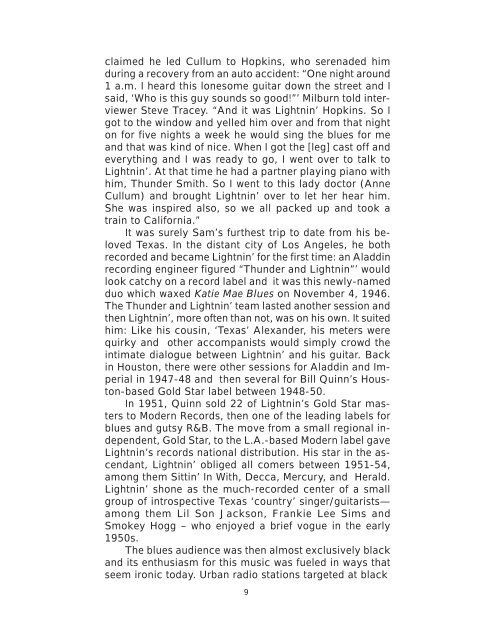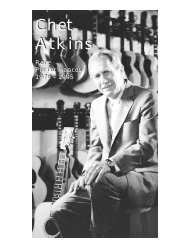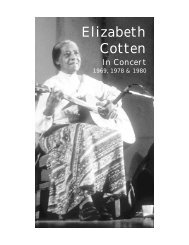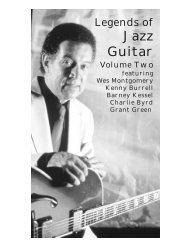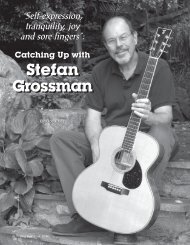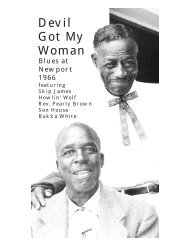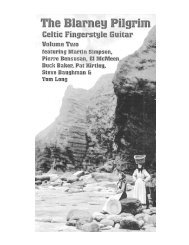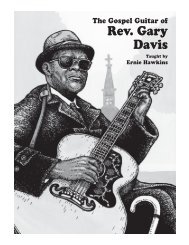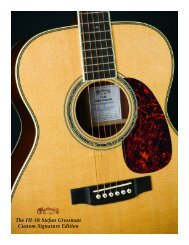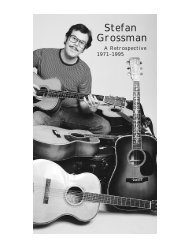Lightnin' Hopkins - Stefan Grossman's Guitar Workshop
Lightnin' Hopkins - Stefan Grossman's Guitar Workshop
Lightnin' Hopkins - Stefan Grossman's Guitar Workshop
Create successful ePaper yourself
Turn your PDF publications into a flip-book with our unique Google optimized e-Paper software.
claimed he led Cullum to <strong>Hopkins</strong>, who serenaded him<br />
during a recovery from an auto accident: “One night around<br />
1 a.m. I heard this lonesome guitar down the street and I<br />
said, ‘Who is this guy sounds so good!”’ Milburn told interviewer<br />
Steve Tracey. “And it was Lightnin’ <strong>Hopkins</strong>. So I<br />
got to the window and yelled him over and from that night<br />
on for five nights a week he would sing the blues for me<br />
and that was kind of nice. When I got the [leg] cast off and<br />
everything and I was ready to go, I went over to talk to<br />
Lightnin’. At that time he had a partner playing piano with<br />
him, Thunder Smith. So I went to this lady doctor (Anne<br />
Cullum) and brought Lightnin’ over to let her hear him.<br />
She was inspired also, so we all packed up and took a<br />
train to California.”<br />
It was surely Sam’s furthest trip to date from his beloved<br />
Texas. In the distant city of Los Angeles, he both<br />
recorded and became Lightnin’ for the first time: an Aladdin<br />
recording engineer figured “Thunder and Lightnin”’ would<br />
look catchy on a record label and it was this newly-named<br />
duo which waxed Katie Mae Blues on November 4, 1946.<br />
The Thunder and Lightnin’ team lasted another session and<br />
then Lightnin’, more often than not, was on his own. It suited<br />
him: Like his cousin, ‘Texas’ Alexander, his meters were<br />
quirky and other accompanists would simply crowd the<br />
intimate dialogue between Lightnin’ and his guitar. Back<br />
in Houston, there were other sessions for Aladdin and Imperial<br />
in 1947-48 and then several for Bill Quinn’s Houston-based<br />
Gold Star label between 1948-50.<br />
In 1951, Quinn sold 22 of Lightnin’s Gold Star masters<br />
to Modern Records, then one of the leading labels for<br />
blues and gutsy R&B. The move from a small regional independent,<br />
Gold Star, to the L.A.-based Modern label gave<br />
Lightnin’s records national distribution. His star in the ascendant,<br />
Lightnin’ obliged all comers between 1951-54,<br />
among them Sittin’ In With, Decca, Mercury, and Herald.<br />
Lightnin’ shone as the much-recorded center of a small<br />
group of introspective Texas ‘country’ singer/guitarists—<br />
among them Lil Son Jackson, Frankie Lee Sims and<br />
Smokey Hogg – who enjoyed a brief vogue in the early<br />
1950s.<br />
The blues audience was then almost exclusively black<br />
and its enthusiasm for this music was fueled in ways that<br />
seem ironic today. Urban radio stations targeted at black<br />
9


